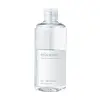What's inside
What's inside
 Key Ingredients
Key Ingredients

No key ingredients
 Benefits
Benefits

 Concerns
Concerns

No concerns
 Ingredients Side-by-side
Ingredients Side-by-side

Water
Skin ConditioningPropanediol
SolventPolyglyceryl-4 Caprate
Emulsifying1,2-Hexanediol
Skin ConditioningPolyglyceryl-6 Caprylate
EmulsifyingPolyglyceryl-6 Ricinoleate
EmulsifyingPolyglyceryl-3 Cocoate
EmulsifyingButylene Glycol
HumectantBetaine
HumectantPanthenol
Skin ConditioningErythritol
HumectantCentella Asiatica Extract
CleansingHouttuynia Cordata Extract
Skin ConditioningIllicium Verum Fruit Extract
PerfumingCaprylyl Glycol
EmollientAllantoin
Skin ConditioningDisodium EDTA
Citric Acid
BufferingSodium Citrate
BufferingWater, Propanediol, Polyglyceryl-4 Caprate, 1,2-Hexanediol, Polyglyceryl-6 Caprylate, Polyglyceryl-6 Ricinoleate, Polyglyceryl-3 Cocoate, Butylene Glycol, Betaine, Panthenol, Erythritol, Centella Asiatica Extract, Houttuynia Cordata Extract, Illicium Verum Fruit Extract, Caprylyl Glycol, Allantoin, Disodium EDTA, Citric Acid, Sodium Citrate
Water
Skin ConditioningDipropylene Glycol
HumectantPolyglyceryl-6 Caprylate
EmulsifyingButylene Glycol
HumectantSodium Hyaluronate
HumectantPanthenol
Skin ConditioningXylitylglucoside
HumectantAnhydroxylitol
HumectantXylitol
HumectantYucca Vera Leaf/Root Extract
MaskingBis-Ethoxydiglycol Cyclohexane 1,4-Dicarboxylate
EmollientPolyglyceryl-10 Stearate
Skin ConditioningPolyglyceryl-10 Polyricinoleate
Emulsifying1,2-Hexanediol
Skin ConditioningCaprylyl Glycol
EmollientWater, Dipropylene Glycol, Polyglyceryl-6 Caprylate, Butylene Glycol, Sodium Hyaluronate, Panthenol, Xylitylglucoside, Anhydroxylitol, Xylitol, Yucca Vera Leaf/Root Extract, Bis-Ethoxydiglycol Cyclohexane 1,4-Dicarboxylate, Polyglyceryl-10 Stearate, Polyglyceryl-10 Polyricinoleate, 1,2-Hexanediol, Caprylyl Glycol
 Reviews
Reviews

Ingredients Explained
These ingredients are found in both products.
Ingredients higher up in an ingredient list are typically present in a larger amount.
1,2-Hexanediol is a synthetic liquid and another multi-functional powerhouse.
It is a:
- Humectant, drawing moisture into the skin
- Emollient, helping to soften skin
- Solvent, dispersing and stabilizing formulas
- Preservative booster, enhancing the antimicrobial activity of other preservatives
Butylene Glycol (or BG) is used within cosmetic products for a few different reasons:
Overall, Butylene Glycol is a safe and well-rounded ingredient that works well with other ingredients.
Though this ingredient works well with most skin types, some people with sensitive skin may experience a reaction such as allergic rashes, closed comedones, or itchiness.
Learn more about Butylene GlycolCaprylyl Glycol is a humectant and emollient, meaning it attracts and preserves moisture.
It is a common ingredient in many products, especially those designed to hydrate skin. The primary benefits are retaining moisture, skin softening, and promoting a healthy skin barrier.
Though Caprylyl Glycol is an alcohol derived from fatty acids, it is not the kind that can dry out skin.
This ingredient is also used as a preservative to extend the life of products. It has slight antimicrobial properties.
Learn more about Caprylyl GlycolPanthenol is a common ingredient that helps hydrate and soothe the skin. It is found naturally in our skin and hair.
There are two forms of panthenol: D and L.
D-panthenol is also known as dexpanthenol. Most cosmetics use dexpanthenol or a mixture of D and L-panthenol.
Panthenol is famous due to its ability to go deeper into the skin's layers. Using this ingredient has numerous pros (and no cons):
Like hyaluronic acid, panthenol is a humectant. Humectants are able to bind and hold large amounts of water to keep skin hydrated.
This ingredient works well for wound healing. It works by increasing tissue in the wound and helps close open wounds.
Once oxidized, panthenol converts to pantothenic acid. Panthothenic acid is found in all living cells.
This ingredient is also referred to as pro-vitamin B5.
Learn more about PanthenolPolyglyceryl-6 Caprylate comes from caprylic acid and Polyglycerin-6. It is an emulsifier, emollient, and cleansing agent.
Emulsifiers help stabilize a product. It does this by preventing certain ingredients from separating. Common ingredients include oils and water, which do not mix naturally. Emulsifiers have properties that help keep ingredients such as these together. There is emerging research that shows emulsifiers may also help in delivering ingredients into the skin.
As an emollient, polyglyceryl-6 caprylate helps soften skin.
Learn more about Polyglyceryl-6 CaprylateWater. It's the most common cosmetic ingredient of all. You'll usually see it at the top of ingredient lists, meaning that it makes up the largest part of the product.
So why is it so popular? Water most often acts as a solvent - this means that it helps dissolve other ingredients into the formulation.
You'll also recognize water as that liquid we all need to stay alive. If you see this, drink a glass of water. Stay hydrated!
Learn more about Water